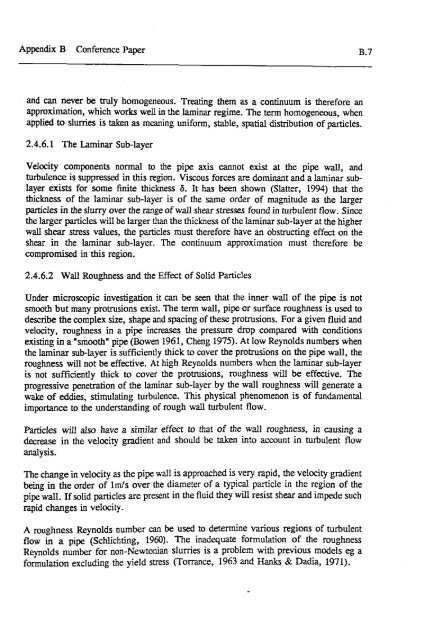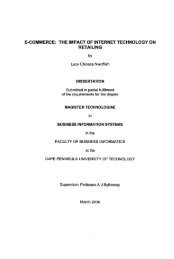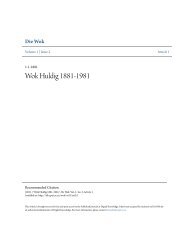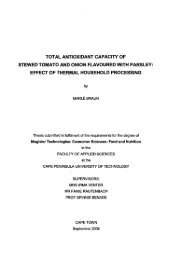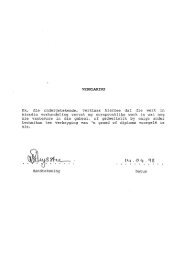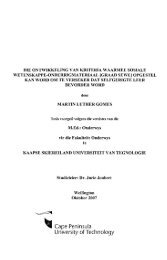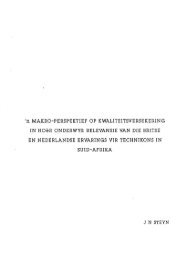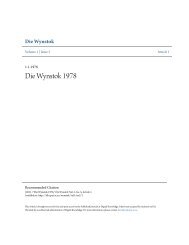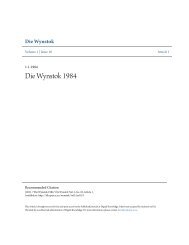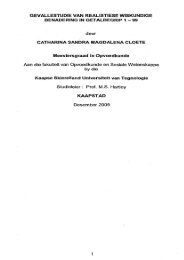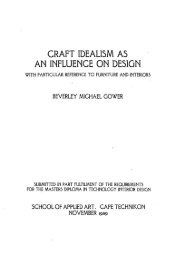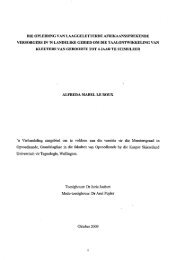the effect of the particle size distribution on non-newtonian turbulent ...
the effect of the particle size distribution on non-newtonian turbulent ...
the effect of the particle size distribution on non-newtonian turbulent ...
You also want an ePaper? Increase the reach of your titles
YUMPU automatically turns print PDFs into web optimized ePapers that Google loves.
Appendix B C<strong>on</strong>ference Paper B.7<br />
and can never be truly homogeneous. Treating <str<strong>on</strong>g>the</str<strong>on</strong>g>m as a c<strong>on</strong>tinuum is <str<strong>on</strong>g>the</str<strong>on</strong>g>refore an<br />
approximati<strong>on</strong>, which works well in <str<strong>on</strong>g>the</str<strong>on</strong>g> laminar regime. The term homogeneous, when<br />
applied to slurries is taken as meaning uniform, stable, spatial <str<strong>on</strong>g>distributi<strong>on</strong></str<strong>on</strong>g> <str<strong>on</strong>g>of</str<strong>on</strong>g><str<strong>on</strong>g>particle</str<strong>on</strong>g>s.<br />
2.4.6.1 The Laminar Sub-layer<br />
Velocity comp<strong>on</strong>ents normal to <str<strong>on</strong>g>the</str<strong>on</strong>g> pipe axis cannot exist at <str<strong>on</strong>g>the</str<strong>on</strong>g> pipe wall, and<br />
turbulence is suppressed in this regi<strong>on</strong>. Viscous forces are dominant and a laminar sublayer<br />
exists for some finite thickness o. It has been shown (Slatter, 1994) that <str<strong>on</strong>g>the</str<strong>on</strong>g><br />
thickness <str<strong>on</strong>g>of</str<strong>on</strong>g> <str<strong>on</strong>g>the</str<strong>on</strong>g> laminar sub-layer is <str<strong>on</strong>g>of</str<strong>on</strong>g> <str<strong>on</strong>g>the</str<strong>on</strong>g> same order <str<strong>on</strong>g>of</str<strong>on</strong>g> magnitude as <str<strong>on</strong>g>the</str<strong>on</strong>g> larger<br />
<str<strong>on</strong>g>particle</str<strong>on</strong>g>s in <str<strong>on</strong>g>the</str<strong>on</strong>g> sluny over <str<strong>on</strong>g>the</str<strong>on</strong>g> range <str<strong>on</strong>g>of</str<strong>on</strong>g>wall shear stresses found in <strong>turbulent</strong> flow. Since<br />
<str<strong>on</strong>g>the</str<strong>on</strong>g> larger <str<strong>on</strong>g>particle</str<strong>on</strong>g>s will be larger than <str<strong>on</strong>g>the</str<strong>on</strong>g> thickness <str<strong>on</strong>g>of</str<strong>on</strong>g> <str<strong>on</strong>g>the</str<strong>on</strong>g> laminar sub-layer at <str<strong>on</strong>g>the</str<strong>on</strong>g> higher<br />
wall shear stress values, <str<strong>on</strong>g>the</str<strong>on</strong>g> <str<strong>on</strong>g>particle</str<strong>on</strong>g>s must <str<strong>on</strong>g>the</str<strong>on</strong>g>refore have an obstructing <str<strong>on</strong>g>effect</str<strong>on</strong>g> <strong>on</strong> <str<strong>on</strong>g>the</str<strong>on</strong>g><br />
shear in <str<strong>on</strong>g>the</str<strong>on</strong>g> laminar sub-layer. The c<strong>on</strong>tinuum approximati<strong>on</strong> must <str<strong>on</strong>g>the</str<strong>on</strong>g>refore be<br />
compromised in this regi<strong>on</strong>.<br />
2.4.6.2 Wall Roughness and <str<strong>on</strong>g>the</str<strong>on</strong>g> Effect <str<strong>on</strong>g>of</str<strong>on</strong>g> Solid Particles<br />
Under microscopic investigati<strong>on</strong> it can be seen that <str<strong>on</strong>g>the</str<strong>on</strong>g> inner wall <str<strong>on</strong>g>of</str<strong>on</strong>g> <str<strong>on</strong>g>the</str<strong>on</strong>g> pipe is not<br />
smooth but many protrusi<strong>on</strong>s exist. The term wall, pipe or surface roughness is used to<br />
describe <str<strong>on</strong>g>the</str<strong>on</strong>g> complex <str<strong>on</strong>g>size</str<strong>on</strong>g>, shape and spacing <str<strong>on</strong>g>of</str<strong>on</strong>g><str<strong>on</strong>g>the</str<strong>on</strong>g>se protrusi<strong>on</strong>s. For a given fluid and<br />
velocity, roughness in a pipe increases <str<strong>on</strong>g>the</str<strong>on</strong>g> pressure drop compared with c<strong>on</strong>diti<strong>on</strong>s<br />
existing in a "smooth" pipe (Bowen 1961, Cheng 1975). At low Reynolds numbers when<br />
<str<strong>on</strong>g>the</str<strong>on</strong>g> laminar sub-layer is sufficiently thick to cover <str<strong>on</strong>g>the</str<strong>on</strong>g> protrusi<strong>on</strong>s <strong>on</strong> <str<strong>on</strong>g>the</str<strong>on</strong>g> pipe wall, <str<strong>on</strong>g>the</str<strong>on</strong>g><br />
roughness will not be <str<strong>on</strong>g>effect</str<strong>on</strong>g>ive. At high Reynolds numbers when <str<strong>on</strong>g>the</str<strong>on</strong>g> laminar sub-layer<br />
is not sufficiently thick to cover <str<strong>on</strong>g>the</str<strong>on</strong>g> protrusi<strong>on</strong>s, roughness will be <str<strong>on</strong>g>effect</str<strong>on</strong>g>ive. The<br />
progressive penetrati<strong>on</strong> <str<strong>on</strong>g>of</str<strong>on</strong>g> <str<strong>on</strong>g>the</str<strong>on</strong>g> laminar sub-layer by <str<strong>on</strong>g>the</str<strong>on</strong>g> wall roughness will generate a<br />
wake <str<strong>on</strong>g>of</str<strong>on</strong>g> eddies, stimulating turbulence. This physical phenomen<strong>on</strong> is <str<strong>on</strong>g>of</str<strong>on</strong>g> fundamental<br />
importance to <str<strong>on</strong>g>the</str<strong>on</strong>g> understanding <str<strong>on</strong>g>of</str<strong>on</strong>g> rough wall <strong>turbulent</strong> flow.<br />
Particles will also have a similar <str<strong>on</strong>g>effect</str<strong>on</strong>g> to that <str<strong>on</strong>g>of</str<strong>on</strong>g> <str<strong>on</strong>g>the</str<strong>on</strong>g> wall roughness, in causing a<br />
decrease in <str<strong>on</strong>g>the</str<strong>on</strong>g> velocity gradient and should be taken into account in <strong>turbulent</strong> flow<br />
analysis.<br />
The change in velocity as <str<strong>on</strong>g>the</str<strong>on</strong>g> pipe wall is approached is very rapid, <str<strong>on</strong>g>the</str<strong>on</strong>g> velocity gradient<br />
being in <str<strong>on</strong>g>the</str<strong>on</strong>g> order <str<strong>on</strong>g>of</str<strong>on</strong>g> lmls over <str<strong>on</strong>g>the</str<strong>on</strong>g> diameter <str<strong>on</strong>g>of</str<strong>on</strong>g> a typical <str<strong>on</strong>g>particle</str<strong>on</strong>g> in <str<strong>on</strong>g>the</str<strong>on</strong>g> regi<strong>on</strong> <str<strong>on</strong>g>of</str<strong>on</strong>g> <str<strong>on</strong>g>the</str<strong>on</strong>g><br />
pipe wall. Ifsolid <str<strong>on</strong>g>particle</str<strong>on</strong>g>s are present in <str<strong>on</strong>g>the</str<strong>on</strong>g> fluid <str<strong>on</strong>g>the</str<strong>on</strong>g>y will resist shear and impede such<br />
rapid changes in velocity.<br />
A roughness Reynolds number can be used to determine various regi<strong>on</strong>s <str<strong>on</strong>g>of</str<strong>on</strong>g> <strong>turbulent</strong><br />
flow in a pipe (Schlichting, 1960). The inadequate formulati<strong>on</strong> <str<strong>on</strong>g>of</str<strong>on</strong>g> <str<strong>on</strong>g>the</str<strong>on</strong>g> roughness<br />
Reynolds number for n<strong>on</strong>-Newt<strong>on</strong>ian slurries is a problem with previous models eg a<br />
formulati<strong>on</strong> excluding <str<strong>on</strong>g>the</str<strong>on</strong>g> yield stress (Torrance, 1963 and Hanks & Dadia, 1971).


